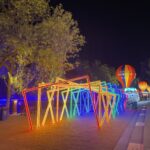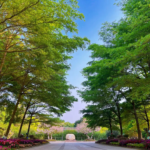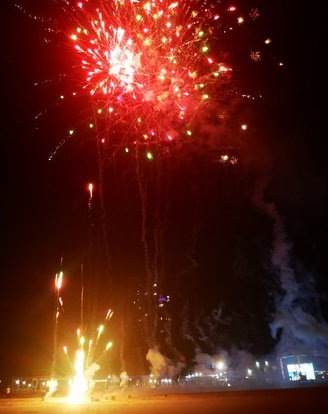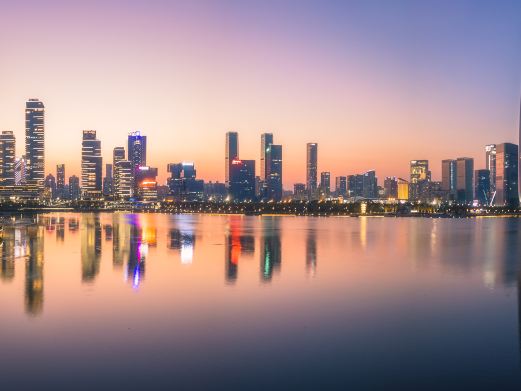Dongpo Academy Introduction: Originally known as Zai Jiu Tang, Dongpo Academy is located in the eastern suburbs of Zhonghe Town, Danzhou City. It was the venue where the great Northern Song Dynasty literati Su Dongpo lectured and met with friends during his three-year residence in Danzhou. The original site of Zai Jiu Tang was the residence of a local person named Li Ziyun. One day, Dongpo, accompanied by Zhang Zhong, the envoy of Changhua Army (Danzhou), visited Li Ziyun and gathered with the local people.
They proposed to build a lecture hall at Li Ziyun’s residence to facilitate Dongpo’s lectures and enlighten the local area. Dongpo gladly approved and named it ‘Zai Jiu Tang’, drawing from the meaning of ‘carrying wine and dishes, following the study’ in the Han Shu · Yang Xiong Biography. According to Xu Zhi, the chief clerk of Danzhou during the Yuan Dynasty, in his ‘Record of Zai Jiu Tang’, Zai Jiu Tang was first built in the fifth year of the Shaosheng era of the Northern Song Dynasty (1098), which was more than half a year after Dongpo arrived in Danzhou in July of the fourth year of Shaosheng.From July of the fourth year of Shaosheng (1097), when Su Dongpo was demoted from Huizhou to Danzhou, until June of the third year of Yuanfu (1100), when Su Dongpo was pardoned and returned north, he lived in Danzhou for three years. During this period, as a literary giant, he personally farmed, encouraged agriculture, changed customs, promoted culture, wrote books, and established theories, earning admiration from the world.
At that time, under the influence of Dongpo’s spirit, the academic atmosphere in Danzhou and the entire Hainan gradually took shape. Jiang Tangzuo, a Qiongzhou scholar who had been taught by him, became the first juren of Hainan the year after he returned north, and in the ninth year after his return north, Fu Que from Changhua Army (Danzhou) passed the imperial examination and became a Jinshi, ending Hainan’s history of having no Jinshi and becoming the first Jinshi of Hainan. Therefore, throughout Hainan’s history, Su Dongpo has been regarded as an important contributor to the enlightenment and development of Hainan’s culture, and his enlightening contribution to Danzhou culture has been passed down through generations. ‘Qiong’s scholars began in Dan, and Qiong’s scholars are also most prosperous in Dan’, this is the immortal contribution of Su Dongpo to the development of Danzhou culture. Today, Dongpo Academy has become a cultural holy land for people from all walks of life and the people of Danzhou to admire through generations. Dongpo Academy was also designated as a key cultural protection unit in 1996, making it one of the important cultural tourist attractions in Hainan.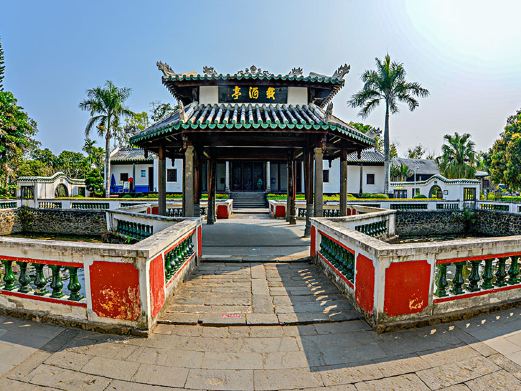
Since its construction during the Northern Song Dynasty, Dongpo Academy went through the Southern Song Dynasty to the early Yuan Dynasty, and the hall was abandoned for a long time without any records of reconstruction. In the spring of the fifth year of the Tai Ding era of the Yuan Dynasty (1328), Peng Ying Lei, the viceroy of Danzhou, rebuilt it on the original site. Since then, through the Ming and Qing dynasties to the early Republic of China, it has been repaired, added, and rebuilt many times.
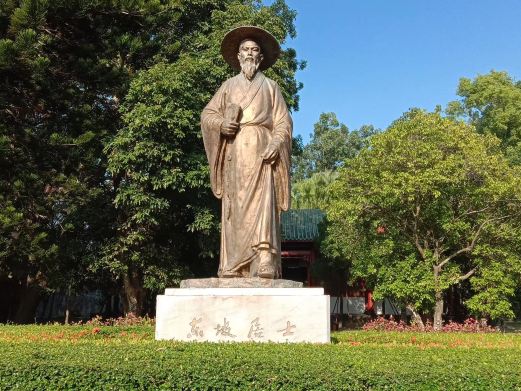
Under the impetus of the Hainan International Tourism Island construction plan, Dongpo Academy, as a cultural heritage unit, has become one of the key tourism projects in Danzhou City and has seen greater development in recent years. From 2012 to 2014, the Danzhou Municipal People’s Government carried out large-scale repairs on the academy, including the main hall, Zaijiu Hall, two side corridors, side rooms, Zaijiu Pavilion, main gate, lotus pond, railings, and Qinshuai Hall. In 2014, a service reception center was added (which has since been changed to the Dongpo Fragrance Culture Museum), and related tourism service facilities were improved according to star standards.
After generations of repairs and expansions, Dongpo Academy has formed a construction scale of 25,040 square meters. The academy houses antique-style buildings such as the main gate, Zaijiu Pavilion, Zaijiu Hall, main hall, side rooms, east and west side corridors, exhibition hall, Qinshuai Hall, Huaixian Pavilion, reception service center, Wangjing Pavilion, and Dongpo Private School. There are also attractions within the academy, including the bronze statues of Dongpo wearing a hat and sandals and sitting, the Spring Ox statue, Dog Flower, Qinshuai Spring Well, and artificial mountains. The academy is lush with vegetation, adorned with flowers, filled with calligraphy and paintings, and exudes an ancient charm, rich in the legacy of Dongpo. Dongpo Academy has a rich collection, including over 400 famous calligraphic works and paintings, 13 couplets from different dynasties, 10 famous plaques, 13 steles from different dynasties, one Ming Dynasty pottery jar, and one Yuan Dynasty stone carving. In addition, there are classical and modern books and materials. The academy features permanent exhibitions: Dongpo’s Life and Deeds Exhibition (Exhibition Hall); Dongpo Historical Materials Exhibition (Main Hall); Exhibition of Steles and Woodcuts from Different Dynasties (Zaijiu Hall). Temporary exhibitions include: Domestic and International Leaders and Experts’ Care Picture Exhibition (East Side Corridor) and Dongpo’s Calligraphy Exhibition. Dongpo Academy, with its numerous exhibits, comfortable environment, rich cultural atmosphere, and abundant and beautiful song and dance performances, is an ideal place for sightseeing and tourism. Historical Evolution of Dongpo Academy: Dongpo Academy was the place where the great Northern Song Dynasty literati Su Dongpo lectured and met friends when he was exiled to Danzhou. It is located in Zhonghe Town, Danzhou City, Hainan Province, 18 kilometers away from Yangpu Port. Dongpo Academy has gone through many vicissitudes and has been repaired, expanded, and protected by various dynasties, forming its current scale. Here is an overview of its historical evolution: Dongpo Academy, originally named Zaijiu Hall, was first built in the first year of the Northern Song Dynasty Yuanfeng (1098 AD). It was initially a thatched cottage. In the third year of the Yuan Dynasty’s Tai Ding (1326 AD), Dongpo Temple was built behind Zaijiu Hall, and Dongpo’s statue was moved from Guanglang Temple into the temple for worship; in the fourth year of Tai Ding (1327 AD), Judge Peng Ying Lei explored the old site, expanded the foundation, and rebuilt the wine hall, which was still a thatched cottage. During the Ming Dynasty, it was repaired many times. In the seventh year of Yongle (1409 AD), the thatched cottage was changed to a tile-roofed house, and during the Zhengde years (1506-1521 AD), a gatekeeper was assigned to serve the temple. In the 23rd year of Wanli (1595 AD), Zaijiu Pavilion, Qinshuai Hall, Qinshuai Spring, and Qinshuai Spring stele were added.In the Qing Dynasty, there were also many renovations. In 1893, the first gate, veranda, and side rooms were added. In 1934, it was renovated again, and Dongpo Park and Dongpo Highway (which was a dirt road at that time) were newly built. Since scholars began to give lectures in Zaojiu Hall during the Jiajing period of the Ming Dynasty (1522 – 1566), carrying forward Dongpo’s legacy. Hence, it is known as ‘Dongpo Academy’. After the liberation of the whole country, the people’s government has allocated funds for repairs many times. Although it was ‘almost completely destroyed’ during the ‘Cultural Revolution’, from 1983 to 1996, the government successively allocated large sums of money to renovate Zaojiu Pavilion, Pan Pool, main hall, Zaojiu Hall, first gate, east and west corridors, side rooms, Qinshuai Spring, and the academy wall. The construction of east and west gardens was improved. A bronze statue of Dongpo wearing a bamboo hat and wooden clogs was erected, and exhibition halls, welcome halls, Wangjing Pavilion, and Qinshuai Hall were built. In 1984, a full-time cultural relic protection institution, the Dongpo Academy Management Office, was established. It is responsible for the protection, management, and scientific research of Dongpo’s cultural historical sites. On November 20, 1996, Dongpo Academy was announced as the fourth batch of key national cultural relic protection units. Scale of Dongpo Academy: The area within the current wall of Dongpo Academy is 25,040 square meters, and the Dongpo Square in front of the outer gate of the wall covers an area of 10. 6 mu. Opening hours: Open all year round from 08:30 to 17:30. Preferential policies: Children: Free for those under 1.2 meters (inclusive). Elderly: Free for those aged 70 years old (inclusive) and above with ID cards. For those aged 60 years old (inclusive) to 70 years old (exclusive), there are preferential policies. Active servicemen: Free with military officer’s certificate, soldier’s certificate or disabled military certificate. Disabled people: Free with disability certificate. College, high school and primary school students: Preferential policies with student ID cards or certificates organized by schools. Supplementary note: The above information is for reference only. Preferential tickets must be purchased on site. Specific details are subject to the announcements of the scenic area.


